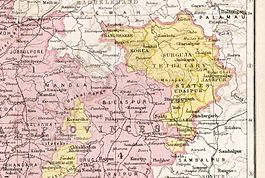Feudatory States in Bihar
The Eastern States Agency was a grouping of princely states in eastern India, during the latter years of Britain′s Indian Empire. It was created in 1933, by the unification of the former Chhattisgarh States Agency and the Orissa States Agency; the agencies remained intact within the grouping. In 1936, the Bengal States Agency was added.
Since the 19th century the princely states and the feudatory states of Orissa and Chota Nagpur were not part of Bengal, but British relations with them were managed by its government through the Bengal Presidency.
The Eastern States Agency was created on 1 April 1933. This agency dealt with forty-two princely states in eastern India, located in the present-day Indian states of Chhattisgarh, Jharkhand, Odisha, West Bengal and Tripura. Before the creation of the Eastern States Agency in 1933, twenty-three native states of the former Orissa Tributary States and Chota Nagpur States were under the suzerainty of the British provinces of Bihar and Orissa and sixteen were under that of the Central Provinces.
Chota Nagpur and Orissa area during the British Raj. Political Divisions. 1909 Imperial Gazetteer of India map section.
The Agent reported to the Governor General of India and two Political Agents under his supervision were posted at Sambhalpur and Raipur.
Cooch Behar and Tripura were transferred from Bengal Province to the Eastern States Agency on 1 November 1936.
On 1 December 1944, the status of this agency was raised to that of a first class residency. These states were grouped into three political agencies, under the “Resident” in Calcutta. The headquarters of the Orissa States Agency was at Sambhalpur, the headquarters of the Chhattisgarh States Agency was at Raipur and the headquarters of the Bengal States Agency was at Calcutta. After the withdrawal of the British from India in 1947, the states acceded to the new Union of India and some of the states formed the Eastern States Union, an organization that failed. Later they were integrated into the Indian states of Madhya Pradesh, Bihar, West Bengal and Orissa. The eastern portion of Madhya Pradesh and the southern portion of Bihar became the states of Chhattisgarh and Jharkhand, respectively, in November 2000.
Orissa States Agency
Salute states:
Narsinghpur, title Raja, Hereditary salute of 11-guns
Kalahandi, title Majaraja, Hereditary salute of 9-guns
Mayurbhanj, title Majaraja, Hereditary salute of 9-guns
Patna, title Majaraja, Hereditary salute of 9-guns
Sonepur, title Majaraja, Hereditary salute of 9-guns
Bengal States Agency
Salute states :
Cooch Behar, title Maharaja, Hereditary salute of 13-guns
Tripura, title Maharaja, Hereditary salute of 13-guns
Chhattisgarh States Agency
Only non-salute states :
Bastar, title Raja (from 1936 Maharaja)
Changbhakar (Chang Bhakar), title Raja (from 1865, Bhaiya)
Chhuikandan (Kondka), title Mahant
Jashpur, title Raja
Chota Nagpur Feudatory States
The Chota Nagpur Feudatory States or Chota Nagpur States were a group of non-salute states (minor princely states) at the time of British Raj, located on the Chota Nagpur Plateau. British suzerainty over the states was exercised through the government of the Bengal Presidency.
These states were nine in number and they became part of the Indian states of Madhya Pradesh, Bihar and Orissa following Indian Independence.
In the 18th century, the states came within the sphere of influence of the Maratha Empire, but they became tributary states of British India as a result of the Anglo-Maratha Wars in the early 19th century.
In October 1905, the exercise of British influence over the predominantly Hindi-speaking states of Chang Bhakar, Jashpur, Koriya, Surguja, and Udaipur was transferred from the Bengal government to that of the Central Provinces, while the two Oriya-speaking states of Gangpur and Bonai were attached to the Orissa Tributary States, leaving only Kharsawan and Saraikela answerable to the Bengal governor.
In 1936, all nine states were transferred to the Eastern States Agency, the officials of which came under the direct authority of the Governor-General of India, rather than under that of any Provinces.
After Indian independence in 1947, the rulers of the states all chose to accede to the Dominion of India. Changbhakar, Jashpur, Koriya, Surguja and Udaipur later became part of Madhya Pradesh state, but Gangpur and Bonai part of Orissa state, and Kharsawan and Saraikela part of Bihar state.
In November 2000, the new states of Chhattisgarh and Jharkhand were separated from Madhya Pradesh and Bihar, respectively.
The following princely states were collectively called Chota Nagpur Feudatory States ::
Bonai
Gangpur
Kharsawan
Saraikela
Chhattisgarh States Agency :
Changbhakar
Jashpur
Koriya (Korea)
Surguja (Sarguja)
Udaipur (Dharamjaigarh)
Patna Princely State
Patna , or Patnagarh, was a princely state in the Central Provinces of India during the British Raj. It had its capital at Balangir (Bolangir). Its area was 6,503 km2 (2,511 sq mi).
Until 1947, it was not part of British India but was subject to the suzerainty of the British crown, under the Orissa States Agency.
In 1947, at the time of the Indian independence, Patna’s ruler did not immediately accede to the newly independent Union of India, delaying accession until 1948. The present day Balangir district is almost coterminous with the boundaries of the former state.
The last ruler of Patna, Rajendra Narayan Singh Deo, built a new career as an elected politician and served as Chief Minister of Orissa from 8 March 1967 to 9 January 1971.
Rulers
The rulers of Patna princely state belonged to the Chauhan Rajput Dynasty and were granted a hereditary salute of 9 guns by the British.
BPCS Notes brings Prelims and Mains programs for BPCS Prelims and BPCS Mains Exam preparation. Various Programs initiated by BPCS Notes are as follows:-